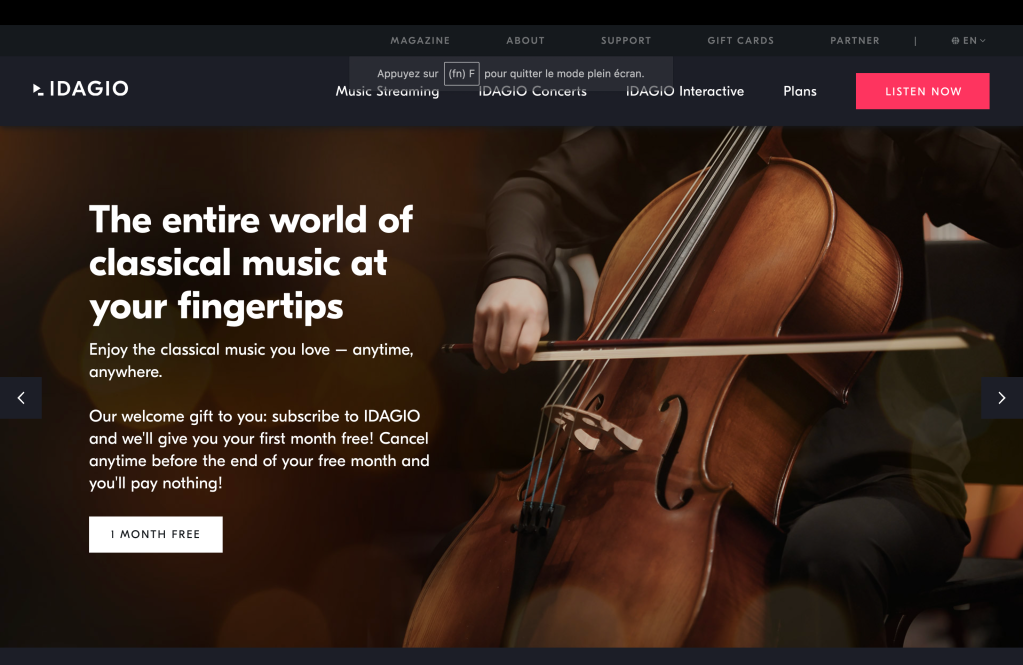In a world dominated by mainstream music streaming giants, classical music enthusiasts often find themselves yearning for platforms that cater specifically to their unique tastes and preferences. While Spotify, Deezer, and Apple Music dominate the market, there are niche platforms that stand out for their dedication to classical music. In this article, I’ll explore three such platforms – Qobuz, Idagio, and Presto Music – comparing their pricing, sound quality, and the impact on artists.
Qobuz: Unrivaled Sound Quality
Qobuz has earned a reputation for its uncompromising commitment to high-fidelity sound. Unlike many mainstream platforms that compress audio files, Qobuz offers streaming in FLAC format, at various resolutions, including MP3 at 320 kbit/s, 16-bit/44.1kHz (CD quality), and 24-bit/96kHz, ensuring that classical music enthusiasts experience the rich nuances and dynamic range of their favorite compositions. This dedication to sound quality comes at a price, with Qobuz offering various subscription tiers to cater to different budgets.
The pricing starts at $10.83 per month for their Studio Premier tier, offering high-resolution streaming, and goes up to $14.99 for the Sublime tier, which includes discounts up to 60% on purchasing high-quality downloads. It also offers duo and family options. While Qobuz may be on the higher end of the price spectrum, its exceptional sound quality makes it a favorite among audiophiles who are willing to invest in an immersive musical experience. In 2018, Qobuz was the streaming app that best compensated artists per stream. However, I have found no recent figures or information about how they currently compensate artists.

Idagio: Tailored for Classical Music Aficionados
Idagio stands out as a streaming platform designed exclusively for classical music lovers. Its user-friendly interface is tailored to accommodate the unique categorization of classical compositions, making it easier for users to discover and explore new pieces. Idagio’s pricing is competitive, with a free tier and a Premium tier at $9.99 per month. For $16,67, subscribers can upgrade to the Idagio Premium + Concerts, which offers unlimited access to Idagio concerts and a dedicated tvOS app for optimal viewing experience.
Idagio’s commitment to classical music is reflected in its pay-per-second model, ensuring that artists receive fair compensation for their work. This approach fosters a sense of support for the classical music community, making Idagio an attractive choice for those who want their subscription fees to directly benefit the artists they admire.

Presto Music: Diverse Music Catalog and Affordable Option
Presto Music, while not exclusively focused on classical music, boasts a diverse catalog that includes an extensive classical repertoire. Priced affordably at $9.99 per month, Presto Music provides users with unlimited access to a vast library of classical compositions. The platform also offers a unique purchase model, allowing users to buy and download high-quality recordings for offline listening.
In terms of artist compensation, Presto Music use a pay-per-second model that ensures artists receive a fair share for each stream. This fair compensation model, combined with a broad range of classical selections, makes Presto Music a noteworthy option for those seeking affordability without compromising quality.

Conclusion
For classical music aficionados seeking a dedicated streaming platform, Qobuz, Idagio, and Presto Music offer unique experiences tailored to their preferences. While Qobuz excels in sound quality, Idagio focuses on a user-friendly interface designed for classical music exploration, and Presto Music provides an affordable yet diverse catalog. Each platform’s commitment to fair artist compensation adds an ethical dimension to the streaming experience, allowing users to support the creators behind the music they love. Ultimately, the best choice depends on individual preferences, budget constraints, and the desired balance between sound quality and affordability.



Laisser un commentaire